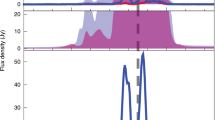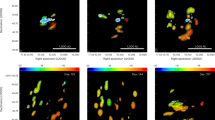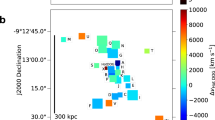Abstract
Numerical simulations have predicted that substructures such as spiral arms can be produced through a gravitationally unstable disk around high-mass young stellar objects (HMYSOs)1,2,3,4,5. Recent high-resolution observations from the Atacama Large Millimeter/submillimeter Array have investigated these substructures at a spatial resolution of ~100 au (refs. 6,7,8,9,10). An accretion burst, which is a manifestation of an increase in the accretion rate caused by a gravitational instability in the disk1,11,12, can result in luminosity outbursting phenomena—as has been seen in several HMYSOs13,14. However, no clear relationship between the accretion bursts and disk substructures has been established. Here we report the detections of three new molecular maser species, HDO, HNCO and 13CH3OH, from the direction of the HMYSO G358.93-0.03 during a 6.7 GHz methanol maser flaring event15. High-quality imaging of the three new maser species exhibits consistent observational evidence that these masers closely trace the spiral-arm substructures around this HMYSO. The rapid decay of the spectral lines emitted from these molecules suggests that these are transient phenomena (for only ~1 month), probably associated with rapid changes in radiation field due to an accretion burst. Therefore, these new maser species provide evidence linking the spiral-arm substructure with an accretion burst, both expected from massive disk instabilities.
This is a preview of subscription content, access via your institution
Access options
Access Nature and 54 other Nature Portfolio journals
Get Nature+, our best-value online-access subscription
$29.99 / 30 days
cancel any time
Subscribe to this journal
Receive 12 digital issues and online access to articles
$119.00 per year
only $9.92 per issue
Buy this article
- Purchase on Springer Link
- Instant access to full article PDF
Prices may be subject to local taxes which are calculated during checkout




Similar content being viewed by others
Data availability
The data from both TMRT and VLA that support the plots within this paper and other findings of this study are available from X.C. on reasonable request. Source data are provided with this paper.
Code availability
The code for the pumping model of HDO and HNCO masers is available at https://github.com/ParfenovS/LVG_LRT
References
Meyer, D. M.-A., Vorobyov, E. I., Kuiper, R. & Kely, W. On the existence of accretion-driven bursts in massive star formation. Mon. Not. R. Astron. Soc. 464, L90–L94 (2017).
Meyer, D. M.-A., Kuiper, R., Kley, W., Johnston, K. G. & Vorobyov, E. Forming spectroscopic massive protobinaries by disc fragmentation. Mon. Not. R. Astron. Soc. 473, 3615–3637 (2018).
Meyer, D. M.-A. et al. On the ALMA observability of nascent massive multiple systems formed by gravitational instability. Mon. Not. R. Astron. Soc. 487, 4473–4491 (2019).
Ahmadi, A., Kuiper, R. & Beuther, H. Disc kinematics and stability in high-mass star formation: linking simulations and observations. Astron. Astrophys. 632, A50 (2019).
Jankovic, M. R. et al. Observing substructure in circumstellar discs around massive young stellar objects. Mon. Not. R. Astron. Soc. 482, 4673–4686 (2019).
Johnston, K. G. et al. Spiral arms and instability within the AFGL 4176 mm1 disc. Astron. Astrophys. 634, L11 (2020).
Maud, L. T. et al. The ALMA view of W33A: a spiral filament feeding the candidate disc in MM1-Main. Mon. Not. R. Astron. Soc. 467, L120–L124 (2017).
Maud, L. T. et al. Substructures in the Keplerian disc around the O-type (proto-)star G17.64+0.16. Astron. Astrophys. 627, L6 (2019).
Ilee, J. D. et al. G11.92-0.61 MM 1: a fragmented Keplerian disk surrounding a proto-O Star. Astrophys. J. Lett. 869, L24 (2018).
Motogi, K. et al. The first birds-eye view of a gravitationally unstable accretion disk in high-mass star formation. Astrophys. J. Lett. 877, L25 (2019).
Laughlin, G. & Bodenheimer, P. Nonaxisymmetric evolution in protostellar disks. Astrophys. J. 436, 335–354 (1994).
Meyer, D. M.-A. et al. Burst occurrence in young massive stellar objects. Mon. Not. R. Astron. Soc. 482, 5459–5476 (2019).
Hunter, T. R. et al. An extraordinary outburst in the massive protostellar system NGC6334I-MM1: quadrupling of the millimeter continuum. Astrophys. J. Lett. 837, L29 (2017).
Garatti, A. C. O. et al. Disk-mediated accretion burst in a high-mass young stellar object. Nat. Phys. 13, 276–279 (2017).
Sugiyama, K., Saito, Y., Yonekura, Y. & Momose, M. Bursting activity of the 6.668-GHz CH3 OH maser detected in G 358.93-00.03 using the Hitachi 32-m. Astron. Telegr. 12446 (2019).
Caswell, J. L. et al. The 6-GHz methanol multibeam maser catalogue: I. Galactic Centre region, longitudes 345∘ to 6∘. Mon. Not. R. Astron. Soc. 404, 1029–1060 (2010).
Breen, S. L. et al. Discovery of six new class II methanol maser transitions, including the unambiguous detection of three torsionally excited lines toward G358.931-0.030. Astrophys. J. Lett. 876, L25 (2019).
MacLeod, G. C. et al. Detection of new methanol maser transitions associated with G358.93-0.03. Mon. Not. R. Astron. Soc. 489, 3981–3989 (2019).
Burns, R. A. et al. A heatwave of accretion energy traced by masers in the G358-MM1 high-mass protostar. Nat. Astron. 4, 506–510 (2020).
Brogan, C. L. et al. Sub-arcsecond (sub)millimeter imaging of the massive protocluster G358.93-0.03: discovery of 14 new methanol maser transitions associated with a hot core. Astrophys. J. Lett. 881, L39 (2019).
Chen, X. et al. 13CH3OH masers associated with an accretion burst in high-mass young stellar object. Astrophys. J. Lett. 890, 22 (2020).
Reid, M. J., Dame, T. M., Menten, K. M. & Brunthaler, A. A parallax-based distance estimator for spiral arm sources. Astrophys. J. 823, 77 (2016).
Hernández-Hernández, V., Zapata, L., Kurtz, S. & Garay, G. SMA millimeter observations of hot molecular cores. Astrophys. J. 786, 38 (2014).
Meyer, D. M., Haemmerlé, L. & Vorobyov, E. I. On the episodic excursions of massive protostars in the Hertzsprung Russell diagram. Mon. Not. R. Astron. Soc. 484, 2482–2498 (2019).
Hosokawa, T., Yorke, H. W. & Omukai, K. Evolution of massive protostars via disk accretion. Astrophys. J. 721, 478 (2010).
Hunter, T. R. et al. The extraordinary outburst in the massive protostellar system NGC 6334I-MM1: emergence of strong 6.7 GHz methanol masers. Astrophys. J. 854, 170 (2018).
Moscadelli, L. et al. Extended CH3 OH maser flare excited by a bursting massive YSO. Astron. Astrophys. 600, L8 (2017).
Izquierdo, A. F. et al. Radiative transfer modelling of W33A MM1: 3D structure and dynamics of a complex massive star-forming region. Mon. Not. R. Astron. Soc. 478, 2505–2525 (2018).
Liu, H. B. et al. ALMA resolves the spiraling accretion flow in the luminous OB cluster-forming region G33.92.0.11. Astrophys. J. 804, 37 (2015).
Audard, M. et al. in Protostars and Planets VI (eds Beuther, H. et al.) 387–410 (Univ. Arizona Press, 2014).
Reipurth, B. & Aspin, C. in Evolution of Cosmic Objects through their Physical Activity: Victor Ambartsumian Centennial Volume (eds Harutyunyan, H. et al.) 19–38 (Gitutyun, 2010).
Nakano, T. Conditions for the formation of massive stars through nonspherical accretion. Astrophys. J. 345, 464–471 (1989).
Jijina, J. & Adams, F. C. Infall collapse solutions in the inner limit: radiation pressure and its effects on star formation. Astrophys. J. 462, 874–887 (1996).
Krumholz, M. R., Klein, R. I., McKee, C. F., Offner, S. S. R. & Cunningham, A. J. The formation of massive star systems by accretion. Science 323, 754–757 (2009).
Kuiper, R., Klahr, H., Beuther, H. & Henning, T. Circumventing the radiation pressure barrier in the formation of massive stars via disk accretion. Astrophys. J. 722, 1556–1576 (2010).
Kuiper, R., Klahr, H., Beuther, H. & Henning, T. Three-dimensional simulation of massive star formation in the disk accretion scenario. Astrophys. J. 732, 20 (2011).
Müller, H. S. P., Thorwirth, S., Roth, D. A. & Winnewisser, G. The Cologne Database for Molecular Spectroscopy, CDMS. Astron. Astrophys. 370, L49–L52 (2001).
Müller, H. S. P., Schlöder, F., Stutzki, J. & Winnewisser, G. The Cologne Database for Molecular Spectroscopy, CDMS: a useful tool for astronomers and spectroscopists. J. Mol. Struct. 742, 215–227 (2005).
Pickett, H. M. et al. Submillimeter, millimeter, and microwave spectral line catalog. J. Quant. Spectrosc. Radiat. Transfer 60, 883–890 (1998).
Gray, M Maser Sources in Astrophysics. (Cambridge Univ. Press, 2012).
Johns, K. P., Cragg, D. M., Godfrey, P. D. & Sobolev, A. M. Class II maser candidates in substituted methanol: CH3 OD, 13 CH3 OH, CH318 OH and CH3 SH. Mon. Not. R. Astron. Soc. 300, 999–1005 (1998).
Sobolev, A. M. & Deguchi, S. Pump cycles and population flow networks in astrophysical masers: an application to class II methanol masers with different saturation degrees. Astrophys. J. 433, 719–724 (1994).
Cragg, D. M., Sobolev, A. M. & Godfrey, P. D. Models of class II methanol masers based on improved molecular data. Mon. Not. R. Astron. Soc. 360, 533–545 (2005).
Schöier, F. L., van der Tak, F. F. S., van Dishoeck, E. F. & Black, J. H. An atomic and molecular database for analysis of submillimetre line observations. Astron. Astrophys. 432, 369 (2005).
Gieser, C. et al. Chemical complexity in high-mass star formation: an observational and modeling case study of the AFGL 2591 VLA 3 hot core. Astron. Astrophys. 631, A142 (2019).
Neill, J. L. et al. The abundance of H2O and HDO in Orion Kl from Herschel/HIFI. Astrophys. J. 770, 142 (2013).
Acknowledgements
We thank TMRT and VLA staff for their assistance in obtaining the data presented in this paper. The National Radio Astronomy Observatory is a facility of the National Science Foundation operated under agreement by the Associated Universities, Inc. X.C. was supported by the National Natural Science Foundation of China (grant numbers 11590781, 11873002, 12011530065 and 11590780), Guangdong Province Universities and Colleges Pearl River Scholar Funded Scheme (2019), Astronomy Science and Technology Research Laboratory of Department of Education of Guangdong Province, and Key Laboratory for Astronomical Observation and Technology of Guangzhou. A.M.S. and S.P. were supported by the Russian Science Foundation (grant number 18-12-00193). S.P.E. acknowledges the support of an ARC Discovery Project (project number DP180101061).
Author information
Authors and Affiliations
Contributions
X.C. and A.M.S. wrote the initial manuscript, obtained and reduced the data, and led the initial observing proposals. Z.-Y.R. carried out the kinematic model analysis for the maser spots. S.P. performed the pumping model calculations for the masers. S.L.B., S.P.E. Z.-Q.S. and B.L. were involved in the initial observing proposal of the VLA and TMRT and helped to improve the manuscript. G.C.M., W.B., C.B., T.H., T.R.H., H.L., K.M., K.S., B.S., Y.G. and X.Z. are members of the M2O group and helped improve to the text.
Corresponding authors
Ethics declarations
Competing interests
The authors declare no competing interests.
Additional information
Publisher’s note Springer Nature remains neutral with regard to jurisdictional claims in published maps and institutional affiliations.
Extended data
Extended Data Fig. 1 The damping factor γ/γ0 as a function of distance from center protostar.
The vertical dashed line denotes the position of turning point (r0 =410 au).
Supplementary information
Supplementary Information
Supplementary Tables 1–6.
Source data
Source Data Fig. 3
Pumping model data.
Source Data Fig. 4
Maser monitoring data.
Rights and permissions
About this article
Cite this article
Chen, X., Sobolev, A.M., Ren, ZY. et al. New maser species tracing spiral-arm accretion flows in a high-mass young stellar object. Nat Astron 4, 1170–1176 (2020). https://doi.org/10.1038/s41550-020-1144-x
Received:
Accepted:
Published:
Issue Date:
DOI: https://doi.org/10.1038/s41550-020-1144-x
This article is cited by
-
Identification of interstellar cyanamide towards the hot molecular core G358.93–0.03 MM1
Astrophysics and Space Science (2023)
-
A Keplerian disk with a four-arm spiral birthing an episodically accreting high-mass protostar
Nature Astronomy (2023)



